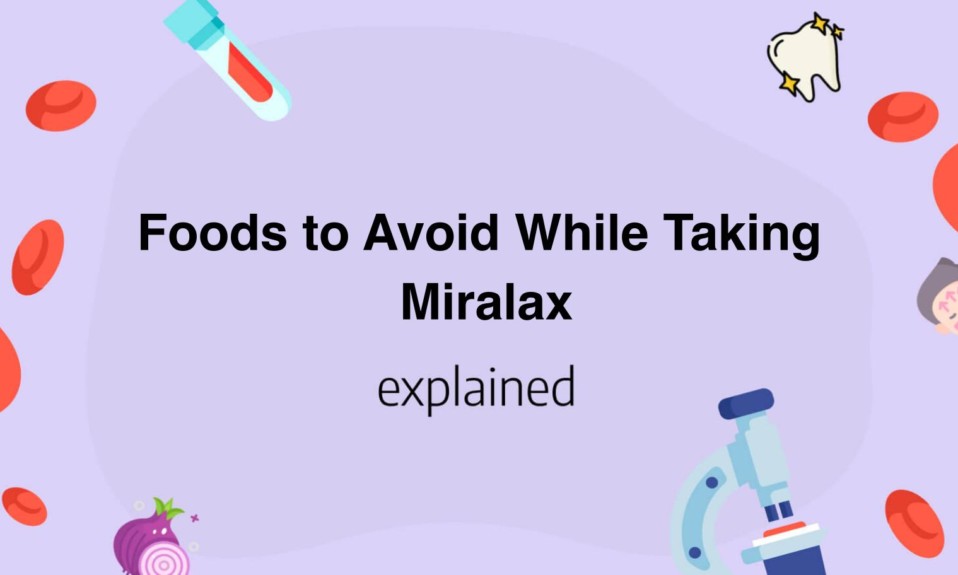If you’re experiencing constipation, Miralax may be the solution for you. However, it’s important to be aware of how diet affects this medication’s performance. To ensure you get the most out of Miralax, here’s everything you need to know about dietary considerations while taking this medication.
Understanding Miralax and Its Uses
Miralax, also known as polyethylene glycol 3350, is a popular over-the-counter laxative used to treat occasional constipation. It works by increasing the amount of water in the stool, making it easier to pass. Unlike other laxatives, Miralax is gentle and produces predictable results without causing bloating, cramping, or sudden urgency in most patients.
Miralax is available in powder form, which should be mixed with a liquid such as water, juice, or soda. The recommended dosage varies depending on the severity of constipation and the patient’s age:
- For adults and children over 17 years old: 17 grams once a day
- For children 6-16 years old: 5 grams once a day
- For children under 6 years old: The dosage should be determined by a doctor
Miralax is not recommended for individuals with a bowel obstruction, severe abdominal pain, nausea, or vomiting. Additionally, it should not be used for more than 7 consecutive days without consulting a doctor. If symptoms persist after 7 days of use, a doctor should be consulted to rule out any underlying medical conditions.
The Importance of Diet When Taking Miralax
Your diet plays a crucial role in how effectively Miralax works. Since Miralax draws water into the intestine to soften stool, proper hydration and certain dietary choices can enhance its effectiveness, while others may work against it.
Balancing Fiber Intake
There’s a common misconception about fiber and Miralax that needs clarification:
- Moderate, soluble fiber can complement Miralax treatment by adding bulk that helps stimulate bowel movements once the stool is softened
- Excessive insoluble fiber (especially when not adequately hydrated) can potentially make stools too bulky and difficult to pass
The key is balance and proper hydration when consuming fiber while taking Miralax.
Foods That May Reduce Miralax’s Effectiveness
Several food categories can potentially interfere with how well Miralax works:
1. Dehydrating Foods and Beverages
Since Miralax requires adequate water to function properly, anything that promotes dehydration can reduce its effectiveness:
- Caffeine: Coffee, tea, energy drinks, and some sodas
- Alcohol: All alcoholic beverages have diuretic effects
- High-sodium foods: Processed foods, canned soups, and salty snacks
2. Constipating Foods
These foods can counteract Miralax’s softening effects:
- High-fat foods: Fried foods, fatty cuts of meat, and full-fat dairy products slow down digestion
- Low-fiber processed foods: White bread, processed snacks, and refined grains lack the fiber needed to promote healthy bowel movements
- Binding foods: Bananas (especially unripe), white rice, applesauce, and toast (the BRAT diet) are traditionally used to firm stools
3. Foods That May Cause Digestive Discomfort
These won’t necessarily reduce Miralax’s effectiveness but may cause discomfort during treatment:
- Gas-producing foods: Beans, lentils, broccoli, and carbonated beverages may increase bloating
- Spicy foods: May irritate the intestines in sensitive individuals
Foods That Support Miralax’s Effectiveness
These dietary choices can enhance how well Miralax works:
1. Hydrating Foods and Beverages
- Water: Aim for at least 8 glasses daily while taking Miralax
- Water-rich fruits and vegetables: Watermelon, cucumber, celery, oranges, grapes, lettuce, and strawberries
- Broth-based soups: Provide both hydration and warmth, which can stimulate bowel movements
- Herbal teas: Non-caffeinated options provide hydration and some herbs may have mild laxative effects
2. Gentle, Natural Laxative Foods
- Prunes and prune juice: Contain natural compounds that stimulate bowel movements
- Kiwi fruit: Studies show it helps increase bowel movement frequency
- Ground flaxseed: When consumed with plenty of water, can help soften stool
Tips on How to Manage Your Diet While on Miralax
For optimal results with Miralax, consider these dietary management strategies:
1. Prioritize Hydration
Miralax works by drawing water into the bowel, so proper hydration is essential:
- Drink at least eight glasses of water per day
- Space your fluid intake throughout the day
- Consider setting reminders to drink regularly
2. Timing Considerations
- Take Miralax on an empty stomach or at least 2 hours after eating for optimal absorption
- Maintain consistent meal times to help establish regular bowel patterns
- Don’t take Miralax immediately before bedtime unless directed by your doctor
3. Gradual Dietary Changes
- Make dietary changes gradually to avoid digestive upset
- Introduce new fiber sources slowly and with plenty of water
- Monitor your body’s response and adjust accordingly
4. Balanced Approach to Fiber
- Focus on soluble fiber sources like oats, barley, and psyllium if consuming fiber
- Ensure adequate hydration when consuming fiber-rich foods
- Avoid extremely high fiber intake all at once
5. Consult Healthcare Professionals
If you’re unsure about what to eat while taking Miralax, consult your doctor or a nutritionist to ensure you’re consuming the right foods for your specific situation.
When to Call Your Doctor
Contact your healthcare provider if:
- Constipation persists after 7 days of using Miralax
- You experience severe abdominal pain or cramping
- You notice blood in your stool
- You develop symptoms of dehydration (extreme thirst, dark urine, dizziness)
- You experience new or worsening symptoms
By following these consistent dietary guidelines and monitoring your response to treatment, you can maximize the benefits of Miralax while minimizing potential side effects or complications.
Disclaimer: This information is for educational purposes only and should not replace professional medical advice. Always consult your healthcare provider before making significant changes to your diet or medication regimen.
Potential Side Effects When Taking Miralax
While Miralax is generally considered safe for short-term use, it’s important to be aware of potential side effects that may occur during treatment. Understanding these effects can help you better manage your experience and know when to consult a healthcare provider.
Common Side Effects
Miralax may cause several mild side effects that typically resolve on their own:
- Bloating: Some patients experience temporary bloating as Miralax draws water into the intestines
- Gas: Increased gas is a common side effect during the first few days of treatment
- Nausea: Mild nausea can occur, especially if taken on an empty stomach
- Cramping: Mild abdominal cramping may happen as bowel movements increase
These side effects are usually mild and temporary, often resolving within the first few days of treatment as your body adjusts to the medication.
Managing Side Effects Through Diet
Certain dietary strategies can help minimize Miralax side effects:
- Start with smaller doses: If recommended by your doctor, beginning with a lower dose and gradually increasing can reduce initial side effects
- Take with meals: Taking Miralax with or shortly after meals may help reduce nausea
- Avoid carbonated beverages: When mixing Miralax powder, use still water or non-carbonated beverages to minimize additional gas
- Limit gas-producing foods: During the first few days of treatment, temporarily reduce foods known to cause gas such as beans, cabbage, and carbonated drinks
When Side Effects May Indicate a Problem
While most side effects are mild, certain symptoms warrant medical attention:
- Severe abdominal pain
- Rectal bleeding
- Signs of allergic reaction (rash, itching, swelling, severe dizziness)
- Symptoms of electrolyte imbalance (irregular heartbeat, muscle weakness, persistent dizziness)
Special Considerations for Long-Term Use
If your doctor has recommended Miralax for longer than the standard 7-day period, additional dietary considerations include:
- Regular electrolyte monitoring: Long-term use may affect electrolyte balance, so consume electrolyte-containing foods and beverages
- Increased fluid intake: Maintaining proper hydration becomes even more important with extended use
- Rotating fiber sources: Vary your fiber sources to ensure a balanced intake of different fiber types
- Probiotic supplementation: Consider adding probiotic foods to support gut flora balance
Interactions with Supplements and Medications
Be aware that certain supplements may interact with Miralax:
- Iron supplements: Take at least 2 hours apart from Miralax
- Calcium supplements: May reduce Miralax effectiveness if taken simultaneously
- Other medications: Generally, take other medications at least 2 hours before or after Miralax to avoid potential absorption issues
Always inform your healthcare provider about all medications and supplements you’re taking before starting Miralax treatment.
This comprehensive understanding of potential side effects and management strategies can help you have a more comfortable experience while taking Miralax for constipation relief.
Read also:










